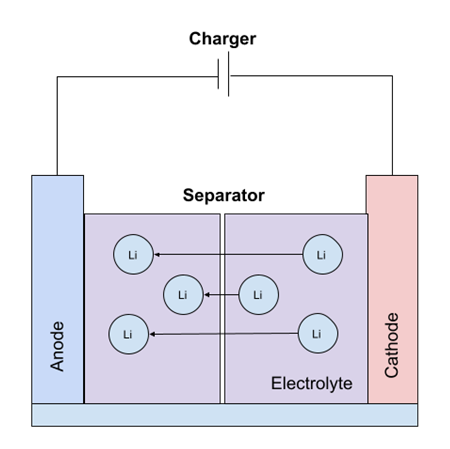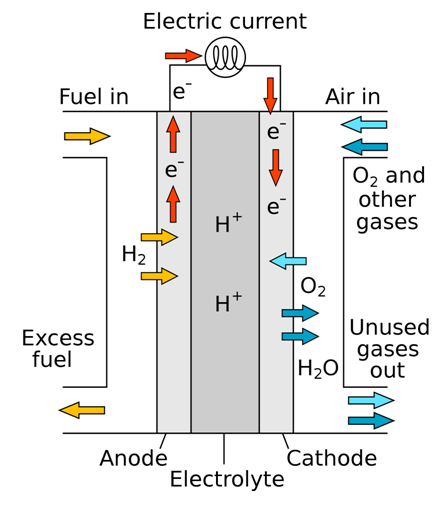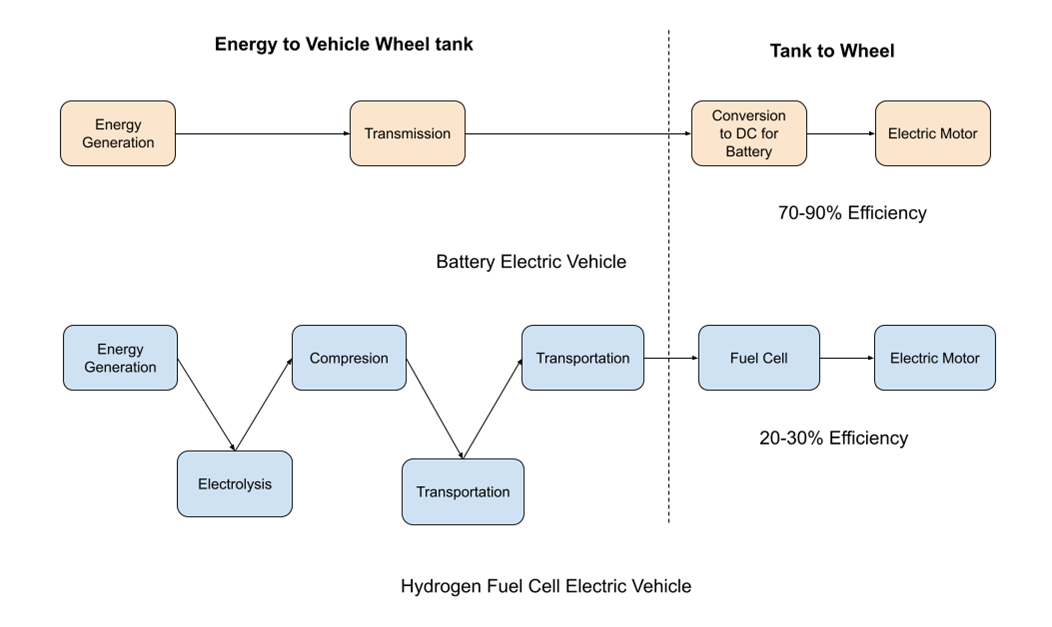Batteries Comparing to Hydrogen Fuel Cells
Written by Binesh Asok Kumar and Abhishek Joshi
One of the most critical problems our planet is experiencing is unpredictable and rapid climate change due to the continuously growing need for energy worldwide, which is now being met by fossil fuels. There is still a long way to go before electric vehicles take the majority share of the global automotive market. However, lithium-ion batteries are used almost entirely to power the electric vehicles on the market today.
Widespread deployment of electric cars requires aid from regulatory bodies and the development of high-performance, low-cost energy storage technology. Examples of this kind of technology include batteries and other electrochemical devices. Concerns over battery capacity and driving range create a technological incentive to improve energy efficiency. The same reasoning may be applied to electric automobiles and buses. However, the evaluation method is made more difficult because the efficiency of Electric Vehicle (EV) motors relies on the load profile and the system's boundaries. There is a possibility that hydrogen fuel cells will be successfully implemented in long-haul trucks, trains, and ambulances. These vehicles would enjoy longer driving ranges, and the construction of infrastructure to fill their bases could be accomplished with relative ease if hydrogen fuel cells were used. In this review, we provide an in-depth study of the most economically viable types of batteries and hydrogen fuel cells that are currently available.
The hydrogen industry has experienced both overly optimistic anticipation and subsequent disillusionment. Despite this, a growing body of evidence suggests that these technologies are a desirable option for the comprehensive decarbonization of global energy systems, and recent developments in their cost and performance show that they have the potential to be economically viable. The purpose of this study is to comprehensively analyze the potential role that hydrogen could play in providing electricity, heat, industry, transportation, and energy storage in a low-carbon energy system. There are already well-established applications of hydrogen, such as forklifts, and more widespread uses are on the horizon. Automobiles running on hydrogen are available for purchase in several countries, and there have been 225,000 installations of fuel-cell home heating systems. This is a dramatic shift from the situation that prevailed just five years ago. Based on the findings of this investigation, significant progress must yet be made before hydrogen can be considered truly competitive in terms of its cost and performance. On the other hand, such competitiveness in the medium term does not appear to be as improbable as it formerly did, which fully explains the growing worldwide interest in these technologies as well as the legislative support they are receiving.
Battery Electric Vehicles
Batteries use lithium ions as their primary energy source. Lithium ions have found their way into consumer electronics and have proven to be a reliable source considering their economic viability with their production cost, weight, and energy density. These batteries constitute an anode (graphite), a cathode (LiMO2), and an electrolyte. During the charge session, the Lithium ions are released by the cathode and get to the anode. During the discharge session, the electronics flow from the anode to the cathode through the load, whereas the Lithium ions go through the separator within the cell to for LiMO2 at the cathode. Typically, the energy density of the LiON range from 260-270 Wh/kg.
Figure 1: Construction of Li-Ion battery cell
BEVs have losses associated with power conversion at the onboard charger or offboard chargers depending on whether the charger is Level1/2 or Leve3, respectively. The efficiency of BEVs from power generation to the vehicle is usually around 70-90%, including the losses associated with power generation and transmission. BEVs have an average range of around 150 miles, with some vehicles going as high as 300 miles. A significant advantage associated with BEVs is the proven commercialization and manufacturability of Lithium-ion batteries, which make investments into this technology attractive with a faster rate of adoption than technologies that don't have this consideration and are in the early stages of development and commercialization.
Some downsides with BEVs include the thermal management requirements due to the risk of combustion. Also, these BEVs have a much higher recharge time, typically around 30 hours with level 1 chargers, 2-5 hours with level 2 chargers, and 20 - 30 minutes with level 3 DC fast chargers. These are much longer than what consumers are used to currently with gasoline cars that can be refuelled in under five minutes. The charging infrastructure is not fully in place to conveniently charge these cars, which is currently one of the biggest barriers for mass-scale adoption. In addition, an aging power grid poses a considerable risk of adding constraints to the grid and needing costly infrastructure upgrades. Hence, there is a need to intelligently manage power behind the meter or keep the power demand below a level where there is no significant burden to the power grid.
Hydrogen Electric Vehicles
Hydrogen is the most abundant element in the world, making it a desirable energy source. However, they are always found bonded with other elements because hydrogen has one electron in its lowest energy level, indicating an unstable arrangement, making it highly reactive. Hence, there these combined elements should go through a process, which in turn consumes electric power, to separate hydrogen which then can be used as a source of energy. There are various ways by which hydrogen can be separated and, depending on the nature of the processes (whether they are using fossil fuels or renewable energy or a combination of both), they are categorized by different color indicators such as blue, green, and green hydrogen.
Since the resurgence of hydrogen is due to the green energy revolution, we will focus on green hydrogen, which uses renewable energy to separate hydrogen through a process called electrolysis.
In the case of electric vehicles, this hydrogen is then transported over a long distance and fed into the car, which has a fuel cell where hydrogen is fed to the anode, and oxygen is fed to the cathode. In this fuel cell, a catalyst at the anode separates hydrogen molecules into protons and electrons, which take different paths to the cathode. The electrons go through an external circuit, creating a flow of electricity, and the proton goes through the separator, such as a proton exchange membrane. The energy density of these types of fuel cells is around 39 kWh/kg.
Figure 2: Construction of Hydrogen Fuel cell
The advantage of hydrogen as a fuel for electric vehicles is that it can be charged faster than batteries, in the order of minutes equivalent to gasoline cars. Also, the higher energy density than batteries means that it can drive much longer ranges and pack more energy in the same space than battery packs. Hence this is a much more attractive option for heavy-duty vehicles, such as trucks. In addition, hydrogen is much safer since there is no risk of combustion in the event of an impact or crash.
Some of the most important disadvantages of hydrogen include the low efficiency compared to batteries, which is only around 30% (although it is still higher than gasoline vehicles). Figure 3 shows the different stages of losses leading up to the 30% efficiency, compared to the battery’s 70-90% efficiency, since the stages of losses are much lower than hydrogen.
Since this technology is still under development and improvement, it is lagging in streamlining its production. As a result, there needs to be more infrastructure setup for hydrogen, and it will need to go through the transition phase that battery vehicles had to go through for their charging infrastructure. Thus, the production and transportation costs for hydrogen are much higher than the electric power generation and transmission for battery vehicles. Therefore, the cost per mile will always be higher in the case of hydrogen.
Figure 3: Efficiency comparison
In general, some of the major factors that are used to compare hydrogen and battery are tabulated in Table 1 below.
Table 1: Battery vs Hydrogen comparison chart
Conclusion
Given the sustainability goals of countries, as well as the clear advantages the battery and hydrogen technologies provide, it is apparent that each of the two technologies is a much better alternative to gasoline engines. Given the complimentary trade-offs between lithium-ion batteries and hydrogen fuel cells, we need a combination of both batteries and hydrogen technologies to have sustainable energy. Breakthrough innovations in these technologies will help propel us into the future and shape how humanity thrives on this planet.
References
- Arsalis, A., Papanastasiou, P. and Georghiou, G.E., 2022. A comparative review of lithium-ion battery and regenerative hydrogen fuel cell technologies for integration with photovoltaic applications. Renewable Energy.
- Gröger, O., Gasteiger, H.A. and Suchsland, J.P., 2015. Electromobility: Batteries or fuel cells? Journal of The Electrochemical Society, 162(14), p.A2605.
- Lin, R.H., Xi, X.N., Wang, P.N., Wu, B.D. and Tian, S.M., 2019. Review on hydrogen fuel cell condition monitoring and prediction methods. International Journal of Hydrogen Energy, 44(11), pp.5488-5498.
- Staffell, I., Scamman, D., Abad, A.V., Balcombe, P., Dodds, P.E., Ekins, P., Shah, N. and Ward, K.R., 2019. The role of hydrogen and fuel cells in the global energy system. Energy & Environmental Science, 12(2), pp.463-491.
- Singla, M.K., Nijhawan, P. and Oberoi, A.S., 2021. Hydrogen fuel and fuel cell technology for cleaner future: a review. Environmental Science and Pollution Research, 28(13), pp.15607-15626.
- Thomas, J.M., Edwards, P.P., Dobson, P.J. and Owen, G.P., 2020. Decarbonising energy: The developing international activity in hydrogen technologies and fuel cells. Journal of Energy Chemistry, 51, pp.405-41
This article was edited by Hossam Gabber.
To view all articles in this issue, please go to February 2023 eBulletin. For a downloadable copy, please visit the IEEE Smart Grid Resource Center.

Binesh Kumar is a technology and engineering leader, who works as a Technical Project Lead at Atom Power Inc., in Charlotte, North Carolina, USA. His background is in Electrical Engineering with areas of expertise in Power Electronics, Embedded Systems, and EV Charging. He is an active IEEE senior member and serves in several leadership roles within IEEE. He has more than seven years of extensive R&D experience. His areas of interest are in Power Electronics (WBGs), Embedded Systems, EV Charging Systems and Standards, Motor Controls, Power Distribution, and Circuit Protection.

Abhishek Joshi received his B.E. degree in electrical engineering from the University of Pune, India, in 2012. He received his M.S. degree in electrical engineering from Michigan Technological University in Houghton, MI, in 2017. From 2012 to 2015, he was an Electrical Engineer at Victor Switchgear an Application Engineer for Low Voltage Switchgear. Currently, he is working with DiGioia Gray, Inc. as a Lead Substation Protection & Control Engineer. His research interests include power system protection, substation automation, and renewable energies.
To have the Bulletin delivered monthly to your inbox, join the IEEE Smart Grid Community.
Past Issues
To view archived articles, and issues, which deliver rich insight into the forces shaping the future of the smart grid. Older Bulletins (formerly eNewsletter) can be found here. To download full issues, visit the publications section of the IEEE Smart Grid Resource Center.







